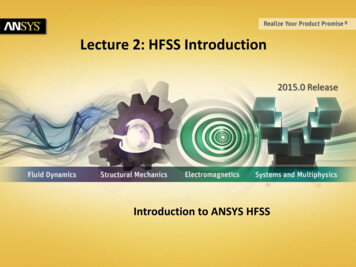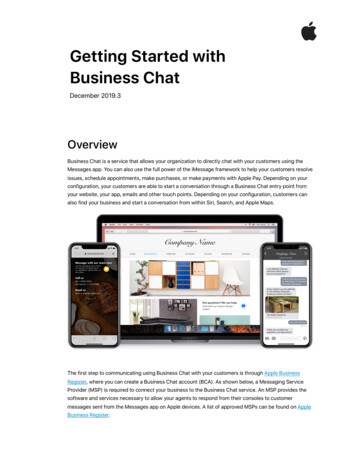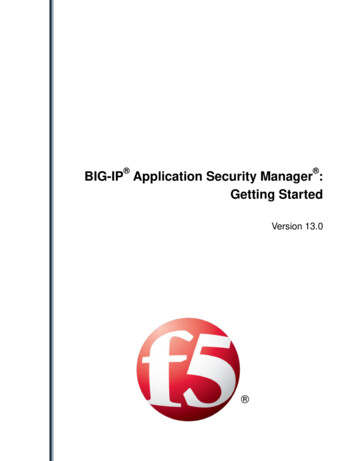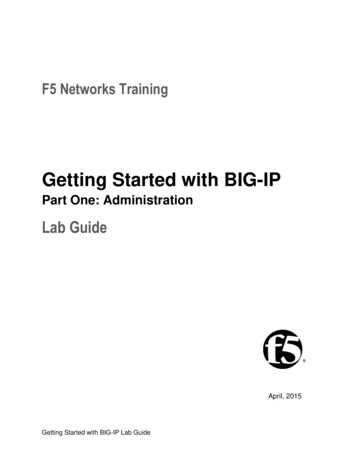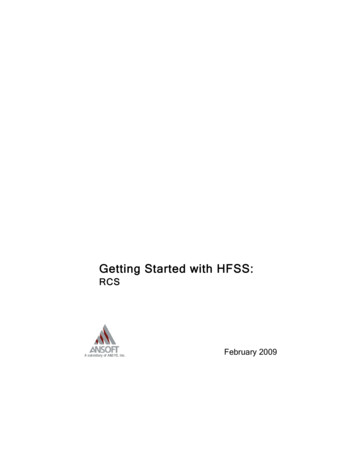
Transcription
Getting Started with HFSS:RCSFebruary 2009
Getting Started with HFSS: RCSThe information contained in this document is subject to changewithout notice. Ansoft makes no warranty of any kind with regard tothis material, including, but not limited to, the implied warrantiesof merchantability and fitness for a particular purpose. Ansoft shallnot be liable for errors contained herein or for incidental or consequential damages in connection with the furnishing, performance,or use of this material. 2009 Ansoft LLC. All rights reserved.Ansoft LLC225 West Station Square DriveSuite 200Pittsburgh, PA 15219USAPhone: 412-261-3200Fax: 412-471-9427HFSS and Optimetrics are registered trademarks or trademarks ofAnsoft LLC. All other trademarks are the property of their respective owners.New editions of this manual incorporate all material updated sincethe previous edition. The manual printing date, which indicates themanual’s current edition, changes when a new edition is printed.Minor corrections and updates that are incorporated at reprint donot cause the date to change.Update packages may be issued between editions and contain additional and/or replacement pages to be merged into the manual bythe user. Pages that are rearranged due to changes on a previouspage are not considered to be revised.iiEditionDa teSoftwareVe rs io n1February 200912
Getting Started with HFSS: RCSConventions Used in this GuidePlease take a moment to review how instructions and otheruseful information are presented in this guide. Alternate methods ortips are listed in the leftmargin in blue italictext. Procedures are presented as numbered lists. A single bullet indicates that the procedure has only one step.Bold type is used for the following:- Keyboard entries that should be typed in their entiretyexactly as shown. For example, “copy file1” means totype the word copy, to type a space, and then to typefile1.- On-screen prompts and messages, names of options andtext boxes, and menu commands. Menu commands areoften separated by carats. For example, clickHFSS Excitations Assign Wave Port.- Labeled keys on the computer keyboard. For example,“Press Enter” means to press the key labeled Enter.Italic type is used for the following:- Emphasis.- The titles of publications.- Keyboard entries when a name or a variable must betyped in place of the words in italics. For example,“copy file name” means to type the word copy, to typea space, and then to type a file name.The plus sign ( ) is used between keyboard keys to indicate that you should press the keys at the same time. Forexample, “Press Shift F1” means to press the Shift keyand the F1 key at the same time.Toolbar buttons serve as shortcuts for executing commands. Toolbar buttons are displayed after the commandthey execute. For example,“On the Draw menu, click Line” means that you canclick the Draw Line toolbar button to execute the Linecommand.iii
Getting Started with HFSS: RCSGetting HelpAnsoft Technical SupportTo contact Ansoft technical support staff in your geographicalarea, please log on to the Ansoft corporate website, http://www.ansoft.com, click the Contact button, and then clickSupport. Phone numbers and e-mail addresses for the technical support staff are listed. You can also contact your Ansoftaccount manager in order to obtain this information.All Ansoft software files are ASCII text and can be sent conveniently by e-mail. When reporting difficulties, it is extremelyhelpful to include very specific information about what stepswere taken or what stages the simulation reached, includingsoftware files as applicable. This allows more rapid and effective debugging.Help MenuTo access online help from the HFSS menu bar, click Help andselect from the menu: Contents - click here to open the contents of the onlinehelp. Seach - click here to open the search function of theonline help. Index - click here to open the index of the online help.Context-Sensitive HelpTo access online help from the HFSS user interface, do one ofthe following: To open a help topic about a specific HFSS menu command, press Shift F1, and then click the command ortoolbar icon. To open a help topic about a specific HFSS dialog box,open the dialog box, and then press F1.iv
Table of Contents1. IntroductionRCS Model . . . . . . . . . . . . . . . . . . . . . . . . . . . . . 1-2General Procedure . . . . . . . . . . . . . . . . . . . . . . . 1-42. Create the RCS ModelCreate the New Project . . . . . . . . . . . . . . . . . . . 2-2Add the New Project . . . . . . . . . . . . . . . . . . . .Insert an HFSS Design . . . . . . . . . . . . . . . . . .Add Project Notes . . . . . . . . . . . . . . . . . . . . . .Save the Project . . . . . . . . . . . . . . . . . . . . . . .2-22-22-32-3Select the Solution Type . . . . . . . . . . . . . . . . . . 2-5Set Up the Drawing Region . . . . . . . . . . . . . . . . 2-5Coordinate System Settings . . . . . . . . . . . . . . . 2-5Units Settings . . . . . . . . . . . . . . . . . . . . . . . . . . 2-6Create the Geometries . . . . . . . . . . . . . . . . . . . . 2-7Create the Target Box . . . . . . . . . . . . . . . . . . .Set the Properties for the Target Box . . . . . . .Create the Air Box . . . . . . . . . . . . . . . . . . . . . .Set the Properties for the Air Box . . . . . . . . . .2-72-72-82-8Create the PML Boundaries . . . . . . . . . . . . . . . 2-9Seed the Mesh on the Airbox . . . . . . . . . . . . . . 2-13Contents-1
Getting Started with HFSS: RCSAdd the Incident Plane Wave . . . . . . . . . . . . . . 2-143. Set Up and Generation SolutionsAdd a Solution Setup to the Design . . . . . . . . . . 1-2Validate the Design . . . . . . . . . . . . . . . . . . . . . . 1-3Analyze the Design . . . . . . . . . . . . . . . . . . . . . . 1-3View the Solution Data . . . . . . . . . . . . . . . . . . 1-4View the Profile Data . . . . . . . . . . . . . . . . . . . . 1-44. Post Processing for RCSCreating the Far Field Infinite Sphere Setups . . 1-2Creating the Monostatic Setup . . . . . . . . . . . . 1-3Creating the Bistatic Setup . . . . . . . . . . . . . . . 1-5Creating a Far-Field Plot for Bistatic RCS . . . . . 1-6Creating a Plot for Monostatic RCS . . . . . . . . . . 1-9Contents-2
1IntroductionThis Getting Started guide is written for HFSS users whoare modeling Radar Cross Section (RCS) in version 12 forthe first time. This guide leads you step-by-step throughcreating, solving, and analyzing the results of a modelthat computes RCS.By following the steps in this guide, you will learn how toperform the following tasks in HFSS:Draw the geometric models.Create the Perfectly Matched Layer (PML) BoundariesAdd the ExcitationSetup Mesh OperationsSpecify solution setting for the design.Validate the design setups.Run HFSS simulations.Create 2D x-y plots.Introduction 1-1
Getting Started with HFSS: RCSRCS ModelThe model for this simulation consists of a perfect electricconducting (pec) target cube surrounded by an airbox. Theairbox is surrounded by a PML boundary. The excitation is aregular plane wave. The model has been kept fairly simple, tokeep the solution time short. The purpose is to illustrate thebasic principles in setting up this kind of problem, and todemonstrate post processing for the RCS information.The radar cross-section (RCS) or echo area, σ , is measured inmeters squared and represented for a bistatic arrangement(that is, when the transmitter and receiver are in differentlocations as shown in the linked figure).1-2 Introduction
Getting Started with HFSS: RCSThe following diagram shows the bistatic RCS concept, withseparate transmitting and receiving antennas.Incident WaveTargetR1Transmitting antennaR2Scattered WaveHFSS supports RCS for Bistatic, Normalized Bistatic, ComplexBistatic, and Monostatic conditions. In this tutorial, you willgenerate plots for Normalized Bistatic and Monostatic situations.Introduction 1-3
Getting Started with HFSS: RCSGeneral ProcedureThe general procedure for creating and analyzing this RCSproject is summarized in the following list:1 Create a project for HFSS.a. Open a new project.b. Add an HFSS design into the new project.2 Draw the geometric model; in this case, a target, and asurrounding airbox that is at least λ 4 from the target.a. Set up the drawing region.b. Create the objects that make up the RCS model.c.Assign materials to the objects. in this case pec for the targetand vacuum for the air box.3 Set up the problem:a. Set up the PML boundary conditions.b. Set up the plane wave excitation.4 Generate a solution:a. Set up the solution criteria and refine the mesh.b. Generate the solution.5 Use Post Processing to Analyze the RCS solution.1-4 Introduction
2Create the RCS ModelThis section shows how to create the simple RCS model.The major steps are as follows.Create a New ProjectCreate the GeometriesCreate the PML BoundariesSeed the MeshAdd the Incident Plane wave.Create the RCS Model 2-1
Getting Started with HFSS: RCSCreate the New ProjectThe first step in using HFSS to solve a problem is to create aproject in which to save all the data associated with the problem. By default, opening HFSS 11 creates a new projectnamed Projectn and inserts a new project named HFSSDesignn, where n is the order in which each was added to thecurrent session.You can also create a new project and insert a design manually as follows.Add the New ProjectTo add a new HFSS project: Click File New.A new project is listed in the project tree in the Project Manager window. It is named projectn by default, where n is theorder in which the project was added to the current session.Project definitions, such as boundaries and material assignments, are stored under the project name in the project tree.Insert an HFSS DesignThe next step for this waveguide combiner problem is toinsert an HFSS design into the new project. By default, adesign named HFSSDesignn with the type as [Driven Modal]appears for the current project.To manually insert an HFSS design into the project, do one ofthe following: Click Project Insert HFSS Design. Right-click on the project name in the Project Managerwindow, and then click Insert Insert HFSS Design on the2-2 Create the RCS Model
Getting Started with HFSS: RCSshortcut menu. Click the Insert HFSS Design toolbar button.A 3D Modeler window appears on the desktop and an HFSSDesign icon is added to the project tree, as shown below:Add Project NotesNext, enter notes about your project, such as its creationdate and a description of the device being modeled. This isuseful for keeping a running log on the project.To add notes to the project:1 Click HFSS Edit Notes.The Design Notes window appears.2 Click in the window and type your notes, such as a description of the model and the version of HFSS in which it isbeing created.3 Click OK to save the notes with the current project.NoteTo edit existing project notes, double-click Notes in theproject tree. The Design Notes window appears, in whichyou can edit the project’s notes.Save the ProjectNext, save and name the new project.Create the RCS Model 2-3
Getting Started with HFSS: RCSIt is important to save your project frequently. Depending on thesetting in Tools Options HFSS General Options dialog, Project Options tab, HFSS can automatically save models at specified intervals.To save the new project:1 Click File Save As.2345NoteThe Save As dialog box appears.Use the file browser to find the directory where you wantto save the file.Type the name rcs example in the File name text box.In the Save as type list, click Ansoft HFSS Project (.hfss)as the correct file extension for the file type.When you create an HFSS project, it is given a .hfss fileextension by default and placed in the Project directory.Any files related to that project are stored in that directory.Click Save.HFSS saves the project to the location you specified.For further information on any topic in HFSS, such ascoordinate systems and grids or 3D Modeler commands orwindows, you can view the context-sensitive help: Click the Help button in a pop-up window.Press Shift F1. The cursor changes to ?. Click on the item withwhich you need help. Press F1. This opens the Help window. If you have a dialogopen, the Help opens to a page that describes the dialog. Use the commands from the Help menu.2-4 Create the RCS Model
Getting Started with HFSS: RCSSelect the Solution TypeBefore you draw the RCS model, first you must specify a solution type. As you set up your model, available options willdepend on the design’s solution type.To specify the solution type:1 Click HFSS Solution Type.The Solution Type window appears.2 This antenna project is a mode-based problem; therefore,select the Driven Modal solution type.The possible solution types are described below.Driven ModalFor calculating the mode-based S-parameters ofpassive, high-frequency structures such asmicrostrips, waveguides, and transmission lines,which are “driven” by a source, and forcomputing incident place wave scattering.Driven Terminal For calculating the terminal-based S-parametersof passive, high-frequency structures with multiconductor transmission line ports, which are“driven” by a source.Results in a terminal-based description in termsof voltages and currents.EigenmodeFor calculating the eigenmodes, or resonances,of a structure. The Eigenmode solver finds theresonant frequencies of the structure and thefields at those resonant frequencies.3 Click OK to apply the Driven Modal solution type to yourdesign.Set Up the Drawing RegionThe next step is to set up the drawing region. For this RCSproblem, you decide the coordinate system, and specify theunits and grid settings.Coordinate System SettingsFor this RCS problem, you will use the fixed, default globalcoordinate system (CS) as the working CS. This is the currentCS with which objects being drawn are associated.Create the RCS Model 2-5
Getting Started with HFSS: RCSHFSS has three types of coordinate systems that let you easilyorient new objects: a global coordinate system, a relativecoordinate system, and a face coordinate system. Every CShas an x-axis that lies at a right angle to a y-axis, and a z-axisthat is perpendicular to the xy plane. The origin (0,0,0) ofevery CS is located at the intersection of the x-, y-, and zaxes.Units SettingsNow, specify the drawing units for your model. For thisantenna problem, set the drawing units to meter.To set the units:1 Click Modeler Units.The Set Model Units dialog box appears.2 Select meter from the Select units menu. Make sure Rescale to new units is cleared.If selected, the Rescale to new units option automaticallyrescales the grid spacing to units entered that are different than the set drawing units.3 Click OK to accept meters as the units for this model.2-6 Create the RCS Model
Getting Started with HFSS: RCSCreate the GeometriesThe geometries for this RCS model consists of the basicobjects listed below with their dimensions:targetA pec box .75 meter square. At the300 Mhz Frequency we use in thesimulation, this is 0.75λair boxA vacuum box 1.4 meter square. Thismeets the requirement that PMLboundaries should be at least λ 4from the target.Create the Target BoxTo create the target box, use the Draw Box command to create a random box, and edit the properties for the followingposition and dimensions:Coordinates-0.375, -0.375, -0.375XSize0.75YSize0.75Set the Properties for the Target BoxTo set the properties for the box:1 Select the newly created box in the history tree, and rightclick Properties from the shortcut menu.234567This displays the Properties dialog.Edit the name field to target.In the materials field, press the button to display theMaterials library dialog.Select pec from the materials list, and click OK to closethe dialogue.In Properties dialogue for the box, Edit the color as a darkred.Set the transparency as 0.6.Click OK to accept the settings and close the dialog.Create the RCS Model 2-7
Getting Started with HFSS: RCSCreate the Air BoxTo create the air box, use the Draw Box command to create arandom box, and edit the properties for the following positionand dimensions:Coordinates-0.7, -0.7, -0.7XSize1.4YSize1.4These dimensions will give the air box a suitable distancefrom the target, greater than λ 4 wavelength on each side,relative to the 300 Mhz frequency we will use.Set the Properties for the Air BoxTo set the properties for the air box:1 Select the newly created box in the history tree, and rightclick Properties from the shortcut menu.2345672-8 Create the RCS ModelThis displays the Properties dialog.Edit the name field to air box.In the materials field, press the button to display theMaterials library dialog.Select vacuum from the materials list, and click OK toclose the dialogue.In Properties dialogue for the box, Edit the color as a lightblue.Set the Transparency as 0.8.Click OK to accept the settings and close the dialog.
Getting Started with HFSS: RCSCreate the PML BoundariesTo create the PML boundaries:1 Set the selection options to Face, either with the menucommand Edit Select Face, the toolbar drop down menufor Face, or the F quick key.2 Select Edit Select By Name, or click the select Icon inthe toolbar.This displays the Select by Face dialog.3 From the Object list, select air box.This lists the names of the air box faces.4 Hold down the Ctrl key, and click each face.All faces of the airbox should be highlighted.5 In the Modeler window, right click to display the shortcutmenu, and select Assign Boundary PML Setup Wizard.Create the RCS Model 2-9
Getting Started with HFSS: RCSThe setup wizard displays.6 In the Uniform Layer Thickness field, set the thickness to0.4 meter. This will keep the solution small enough for thisexercise. The layers' material parameters will be adjusted2-10 Create the RCS Model
Getting Started with HFSS: RCSautomatically in accordance with the new thickness.7 Leave the Create joining corner and edge objects checkbox selected, and click Next.This creates the PML objects, and displays the MaterialCreate the RCS Model 2-11
Getting Started with HFSS: RCSParameters dialog.8 Set the Minimum Frequency to 0.3 Ghz, and the MinimumRadiating Distance to 0.3 meter, as shown.2-12 Create the RCS Model
Getting Started with HFSS: RCS9 Click Next to display the PML Summary dialog.10 Click Finish to close the dialog.The PML boundaries are listed under Boundaries in theProject tree, and the PML objects are listed in the Historytree.Create the RCS Model 2-13
Getting Started with HFSS: RCSSeed the Mesh on the AirboxSeed the mesh on the air box to λ 5 . This will result in avery accurate radiation pattern.1 Select the faces of the air box2 Right click on Mesh Operations in the Project tree.3 Click Assign On Selection Length Based.This displays the Element Length Based Refinement dialog.4 Set the Maximum length of Elements value to 0.2 with theunits as meter.5 Click OK to close the dialog.The Length1 icon appears under Mesh Operations in theProject tree.2-14 Create the RCS Model
Getting Started with HFSS: RCSAdd the Incident Plane WaveAn incident plane wave is a wave that propagates in onedirection and is uniform in the directions perpendicular to itsdirection of propagation.1 Click HFSS Excitations Assign Incident Wave PlaneWave.23456The Incident Wave Source: General Data page appears.Type the source’s name in the Name text box or accept thedefault name.Select the Vector Input Format as Spherical coordinates.Enter 0, 0, 0 for the X-, Y-, and Z-coordinates of the Excitation Location and/or Zero Phase Position (the origin forthe incident wave).Click Next.The Incident Wave Source: Spherical Vector Setup pageappears.a. Under IWaveTheta, enter 0 deg for Start, 90 deg for Stop,and 3 for Step. For the monostatic case, the RCS will becomputed only at values of IWave θ entered here. For thepurposes of this demo, this keeps the number points downand to save on the solution timeb. Click View Point List to see the values of θ.7 Click Next. the Incident Wave Source: Plane WaveOptions page appears.8 Select the Type of Plane Wave.9 Select Regular/Propagating, so no other fields are active.10 Click Finish. The incident wave you defined is added tothe Excitations list in the Project.Create the RCS Model 2-15
Getting Started with HFSS: RCS2-16 Create the RCS Model
3Set Up and GenerationSolutionsIn this chapter you will complete the following tasks:Add a solution setup.Add a frequency sweep to the solution setup.Validate the design.Run the analysis.Set Up and Generation Solutions 3-1
Getting Started with HFSS: RCSAdd a Solution Setup to the DesignSpecify how HFSS will compute the solution by adding a solution setup to the design.In the solution setup, you will instruct HFSS to perform anadaptive analysis at 10 GHz. During an adaptive analysis, HFSSrefines the mesh iteratively in the areas of highest error.1 In the project tree, under the rcs example design, rightclick Analysis, and then click Add Solution Setuponthe shortcut menu.2345The Solution Setup dialog box appears.Under the General tab, type 0.3 in the Solution Frequency text box, and leave the default unit set to GHz.Leave the Maximum Number of Passes set to 6. This is themaximum number of mesh refinement cycles that HFSSwill perform.Leave Maximum Delta energy at 0.1.Leave the default settings and clickOK.The solution setup is listed in theproject tree under Analysis. It isnamed Setup1 by default.3-2 Set Up and Generation Solutions
Getting Started with HFSS: RCSValidate the DesignBefore you run an analysis, it is helpful to verify that all of thenecessary setup steps have been completed and their parameters are reasonable.1 On the HFSS menu, click Validation Check.HFSS checks the project setup, and then the ValidationCheck window appears.2 Click Close.Now you are ready to run the simulation.Analyze the DesignNow you will run the simulation.On the HFSS menu, click Analyze All.HFSS computes the 3D field solution for every solution setupin the project. In this problem, Setup1 is the only setup.The solution process is expected to take approximately 5 to30 minutes, depending on the machine speed and load.When the solution is complete, a confirmation messageappears in the Message Manager.The Progress window displays the solution progress as itSet Up and Generation Solutions 3-3
Getting Started with HFSS: RCSoccurs:NoteThe results that you obtain should be approximately thesame as the ones given in this section. However, there maybe a slight variation between platforms.View the Solution DataWhile the analysis is running, you can view a variety of profile, convergence, and matrix data about the solution.View the Profile DataWhile the solution proceeds, examine the computingresources, or profile data, used by HFSS during the analysis.The profile data is essentially a log of the tasks performed byHFSS during the solution. The log indicates the length of timeeach task took and how much RAM/disk memory wasrequired.3-4 Set Up and Generation Solutions
4Post Processing forRCSThis chapter describes how to create the geometry setupsfor monostatic and bistatic infinite spheres. You can thencreate plots for these geometries for a Normalized BistaticRCS and Monostatic RCS. Normalized RCS means RCS normalized with respect to wavelength squared.Post Processing for RCS 4-1
Getting Started with HFSS: RCSCreating the Far Field Infinite SphereSetupsTo evaluate radiated fields in the far-field region, you mustset up an infinite sphere that surrounds the radiating object.For this example, we will create setups for the bistatic andmonostatic cases.When you set up a spherical surface over which to analyzenear or far fields, you specify a range and step size for phiand theta. These indicate the spherical direction in which youwant to evaluate the radiated fields. For every value of phithere is a corresponding range of values for theta, and viceversa. This creates a spherical grid. Each grid point indicatesa unique direction along a line that extends from the centerof the sphere through the grid point. The radiated field isevaluated in this direction. The number of grid points isdetermined by the step size for phi and theta.The sphere can be defined according to any defined coordinate system and before or after a solution has been generated.The relationship between phi and theta is shown below.φ is rotated away from the x-axis.θ is rotated away from the z-axis.θφxyWhen HFSS evaluates the radiated fields, it needs at least twodirections along which to plot the fields. Therefore, if thestep size for phi is zero, then the step size for theta must begreater than zero, and vice versa. This ensures that the fieldsare plotted in at least two directions.4-2 Post Processing for RCS
Getting Started with HFSS: RCSCreating the Monostatic Setup1 Click HFSS Radiation Insert Far Field Setup InfiniteSphere.The Far Field Radiation Sphere Setup dialog appears.2 Under the Infinite Sphere tab, type a name for the spherein the Name text box.For the monostatic sphere, type the name monostatic.3 Specify the range of angles to include in the sphere. Forthe monostatic case, phi and theta will be dummy values.Post Processing for RCS 4-3
Getting Started with HFSS: RCSThe reason is that when we ask, later, for a plot of monostatic RCS, the software will know in which direction tocompute the far field for every incident angle: iwavethetaand iwavephi from the excitation setup.a. Specify the following for Phi, in degrees (deg) or radians(rad):StartThe point where the rotation of phi begins.Leave this as 0.StopThe point where the rotation of phi ends. The Stopvalue must be greater than or equal to the Startvalue and less than 360. If the Stop value is equal tothe Start value, then HFSS assumes that only oneangle should be used and the Step Size value will beignored.Set this to 0.Step SizeThe number of degrees or radians (spherical gridpoints) between the sweep of phi. Entering zero forthe Step Size causes the sweep to consist of onepoint, the start value. If the Step Size value is zero,then HFSS assumes that only one angle should beused.Set this to 0.b. Specify the following for Theta, in degrees (deg) or radians4-4 Post Processing for RCS
Getting Started with HFSS: RCS(rad):StartThe point where the rotation of theta begins. TheStart value must be greater than -90 degrees, or theequivalent in radians.Set this to 0.StopThe point where the rotation of theta ends. The Stopvalue must be greater than the Start value and lessthan 90 degrees, or the equivalent in radians. If theStop value is equal to the Start value, HFSS assumesthat only one angle should be used and the Step Sizevalue will be ignored.Set this to 0.Step SizeThe number of degrees or radians (spherical gridpoints) between the sweep of theta.Entering zero for the number of steps causes thesweep to consist of one point, the Start value. If theStep Size value is zero, then HFSS assumes that onlyone angle should be used.Set this to 0.4 Click the Coordinate System tab, and then to orient thesphere according to the global coordinate system (CS),select Use global coordinate system. If you needed to orient the sphere according to a userdefined CS, you would select Use local coordinate systemand then select a defined CS from the Choose from existingcoordinate systems list.5 Click the Radiation Surface tab.Leave the selection as Use Boundary Radiation Surfaces.If you needed to specify a surface other than an assignedradiation or PML boundary over which to integrate theradiated fields, you could select Use Custom RadiationSurface.6 Click OK.The monostatic infinite sphere is created. It is listed in thePost Processing for RCS 4-5
Getting Started with HFSS: RCSproject tree under Radiation.NoteYou must have defined at least one radiation or PML boundary inthe design for HFSS to compute far-field quantities, regardless ofwhich radiation surfaces you instruct HFSS to use when calculatingthe far fields. You do not need to re-solve the problem if youmodify radiation surfaces in the Far Field Radiation Sphere Setupwindow.Creating the Bistatic Setup1 In the Project tree, right-click on Radiation and from theshort cut menu click Insert Far Field Setup InfiniteSphere.2345The Far Field Radiation Sphere Setup dialog appears.This time specify the name as bistatic.Set the Phi Start, Stop, and Step values as 0.Set the Theta Start value as 0, the Stop value as 180 degand the Step values as 1.Click OK to close the dialog.The bistatic setup appears under Radiation in the Projecttree.4-6 Post Processing for RCS
Getting Started with HFSS: RCSCreating a Far-Field Plot for Bistatic RCSFirst, create a plot for bistatic RCS.To select a far-field quantity to plot:1 To create the report, right-click on the Results icon in theProject tree, and select Create Far Fields Report Rectangular Plot.2345This displays the New Report - New Traces dialog.Leave the Context selection for the Solution as Setup1:LastAdaptive.In order to plot the RCS, you select one of the geometriesyou created from the Geometry list in the Traces dialog.For this plot, select Bistatic as the Geometry.For Category, select Normalized Bistatic RCS.This selection causes the Quantity list to show NormRCSquantities for Total, Phi, Theta, X, Y, and Z, with TotalSelected.For the function, select dB function.After these sections, the Y field under Trace showsdb(NormRCSTotal). The X value will be the Theta for thePost Processing for RCS 4-7
Getting Started with HFSS: RCSincident wave defined for the simulation6 Click on the Families tab and verify that IWaveTheta 0,meaning that of all the incident waves, we are going toplot the bistatic pattern of this one only.7 Click New Report.This generates the report, adding it to the Project tree,and causes it to display.4-8 Post Processing for RCS
Getting Started with HFSS: RCS8 Click Close to close the Report.Post Processing for RCS
Getting Started with HFSS: RCS iii Conventions Used in this Guide Please take a moment to review how instructions and other useful information are presented in this guide. Procedures are presented as numbered lists. A single bul-let indicates that the procedure


